The Google Pixel 3a XL Review: Does Mid-Range Make Sense?
by Andrei Frumusanu on June 27, 2019 8:00 AM EST- Posted in
- Mobile
- Smartphones
- Snapdragon 670
- Pixel 3a
- Pixel 3a XL
Display Measurement
The display on the Pixel 3a XL is well specced for its range and price; the fact that Google opted to still employ an OLED panel rather than adopting a cheaper LCD does very well for the value of the new phone and does manage to differentiate itself from a lot of other devices from the competition, although we have seen more widespread adoption of OLED even in this tier.
Both the Pixel 3a and Pixel 3a XL display panels are exclusively made by Samsung and use Samsung DDICs, which is a safe choice given the display issues we’ve encountered on past LG-sourced Pixel devices.
As always, we thank X-Rite and SpecraCal, as our measurements are performed with an X-Rite i1Pro 2 spectrophotometer, with the exception of black levels which are measured with an i1Display Pro colorimeter. Data is collected and examined using SpectraCal's CalMAN software.

In terms of display brightness, it’s relatively on par with the manual maximum brightness levels we’ve seen from many OLED devices, with the Pixel 3a XL falling in at ~410 nits in the Natural display mode.
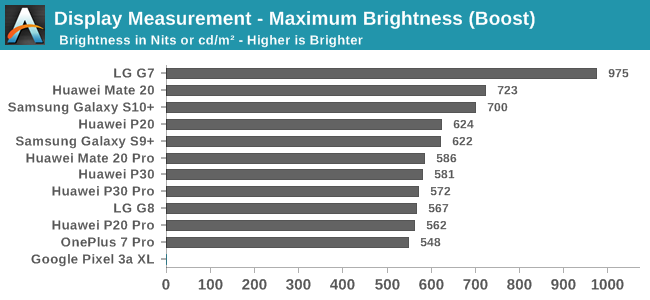
Unfortunately there’s no boost mechanism available, and the auto mode doesn’t have any high ambient brightness mode.
In terms of display modes, Google continues on with what we’ve seen in the Pixel 3. We have the “Natural”, “Boosted” and “Adaptive” modes. The phone by default comes in the Adaptive mode which is a highly saturated inaccurate mode. It’s been hinted to me that the reason Google opts to deliver the phone in this mode is because of pressure such as Samsung also having defaulted to saturated colours; however with this year’s phones this is no longer the case as the Korean vendor opted to ship it with accurate colours out-of-the-box, so I hope later this year Google will follow up doing the same in the Pixel 4.
The Natural mode is the phone’s most accurate colour profile and is colour managed, with accurate sRGB and Display P3 gamut targets. We’ll be remaining in this mode for our testing.
Starting off the greyscale accuracy tests, we see that the Pixel 3a XL does extremely well in the colour temperature department, achieving near perfect whites with an average CCT of 6428. The phone’s colour temperature seems to remain steady across brightness levels, although at lower brightness settings it does get a bit warmer towards 6100K. Nevertheless the differences are not perceptible and it’s a great result.
Minimum brightness falls in at 2.4nits, which is a little bit brighter than other phone’s minima, but it’s still adequate enough for evening low-light reading. As mentioned, the maximum falls in at 410nits at full-screen white with no further boosting. I did note that the screen does have APL brightness scaling, and did measure it go around 500 nits when showing lesser picture levels.
I did find some issues with the gamma: Oddly enough at 100 APL the results are near outstanding, and the 3a XL is able to achieve leading results with an almost perfect gamma as well as a greyscale dE2000 of 0.71.
The issue is, when going towards lower APL patterns, this behaviour falls apart and the panel clearly misbehaves in terms of luminosity and we’re seeing a gamma of 2.4-2.5.
 Greyscale 200nits APL100 SpectraCal CalMAN
Greyscale 200nits APL100 SpectraCal CalMAN Greyscale 200nits APL65 SpectraCal CalMAN
Greyscale 200nits APL65 SpectraCal CalMAN

Overall, because of the gamma issue, the phone ends up with a dE2000 of 2.21, which is still quite good. Please do keep in mind the gamma issues here as we’ll shortly see more drastic effects in the latter Gretag-MacBeth test.

Natural Mode - sRGB - SpectraCal CalMAN
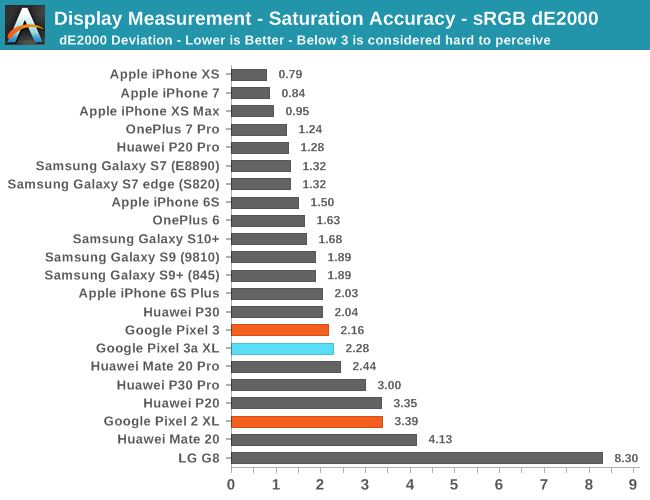
Saturation accuracy for sRGB content is ok with an overall dE2000 of 2.28. The issue here is that the reds and blues are slightly undersaturated at all levels, which does reduce the gamut coverage of the panel.
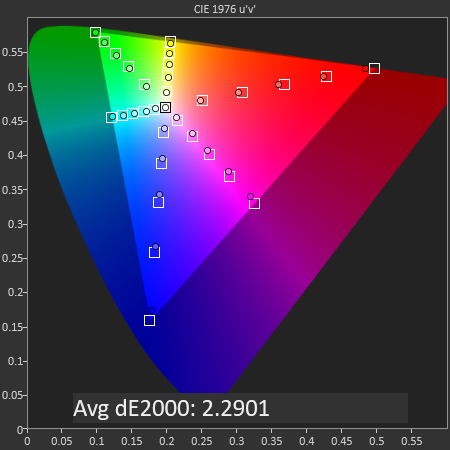
Natural Mode - Display P3 - SpectraCal CalMAN
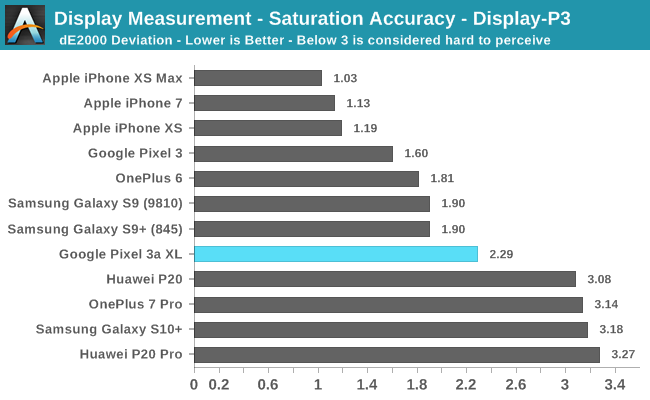
Display P3 content showcases the same issues of being under-saturated in the red and blues, also not quite reaching the maximum gamut of the colour space in this regard. Nevertheless, it’s a relatively errors are relatively linear so other than a slight under-saturation you will not see too major errors in terms of chromacity of colours.
In the Gretag Macbeth colour test with commonly found tones we see some of the larger issues of the Pixel 3a XL’s calibration:
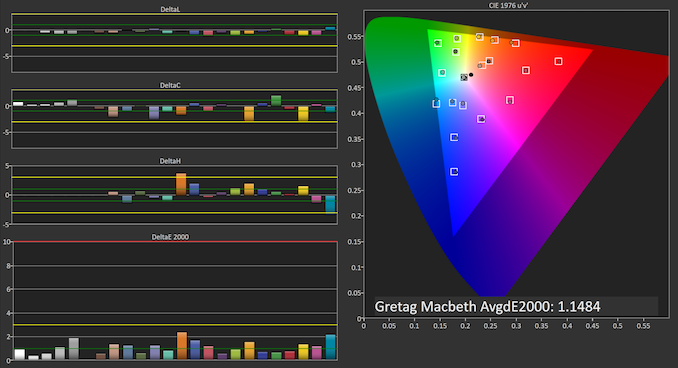
GMB Natural - Sequentual APL100 SpectraCal CalMAN
If we’re testing the colour patches sequentially at APL100 we are seeing some outstanding results with extremely accurate colours, with only a few tones being off-mark. The dE2000 here would have ended at 1.14 which is top-of-the-line.

GMB Natural - Sequential APL65 - SpectraCal CalMAN
If however we test the pattern on a lower fixed APL (as we usually do), then we’re seeing some large errors in terms of luminosity, and we’re seeing the effects of the larger than optimal gamma we discovered before. Here the dE2000 of the GMB test falls in at 3.06, slightly above the limit of what should be acceptable.
However I wasn’t quite satisfied with my results as I noted that the phone was not actually behaving correctly even with fixed APL patterns. I noticed that luminosity also is highly dependent on the pattern window size, meaning the panel scales not only scales with APL, but also based on the % of pixels which are white. This causes quite a headache as it’s not actually possible to sequentially display automated patterns while keeping the luminosity constant.
I went ahead and just transferred our GMB colour patches onto a single static image and measured each square thanks to the small read head of the i1Pro.
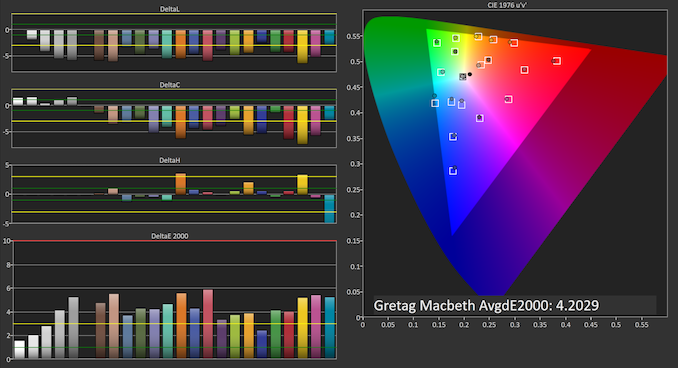
GMB Natural Side-by-Side Patches SpectraCal CalMAN
When measuring things in this manner, we actually see that things are actually worse than with the automated fixed APL method.
What’s actually happening here seems all too obvious: Google did very evidently calibrate their panels, however they did a massive mistake in their methodology. Either the engineers calibrated the display with full-screen and varying APL patches, which would pretty much explain the near absolute perfect results we’re measuring on the 3a XL, or the APL mechanism was enabled after the colour calibration took place. In my view I would point out to the former as the results are too perfect.
Unfortunately this does have a larger impact on the colour accuracy of the screen as we end up with an effective gamma of 2.5-2.6, and as seen in the final comparison picture colours are far too dark in relation to white, resulting in artificially more contrast.

Unfortunately this behaviour was actually also present on the Pixel 3 – however not quite with such a large difference. I do very much apologise to our readers for not catching this mistake last year, and in the future I’ll keep a closer eye on such behaviour. I’ve re-measured the Pixel 3 and it does very much negatively impact the accuracy score.
As for the Pixel 3a XL, this also does have a bad impact as the phone ends up with a dE2000 of 4.20 in the GMB chart.
Overall Display Conclusion: Still Good, Albeit Obvious Miscalibration
Overall the Pixel 3a XL display is still a good display. Having an OLED panel at this price category does remain a large advantage for the phone. Viewing angles and constrast are excellent, and while it doesn’t compete with flagships for brightness, it’s still very excellent and results in good sun-light legibility. The panel quality is excellent and the Samsung-sourced unit doesn’t exhibit any issues previously encountered on LG-sourced panels, and characteristics such as base power consumption are good.
It’s a pity for the colour calibration: Google very obviously paid attention to this and attempted to give the phone accurate colours, but they made a huge mistake in their methodology which results in the phone effectively having very inaccurate gamma and colour luminosity in actual content, resulting in darker-than-should-be colours.


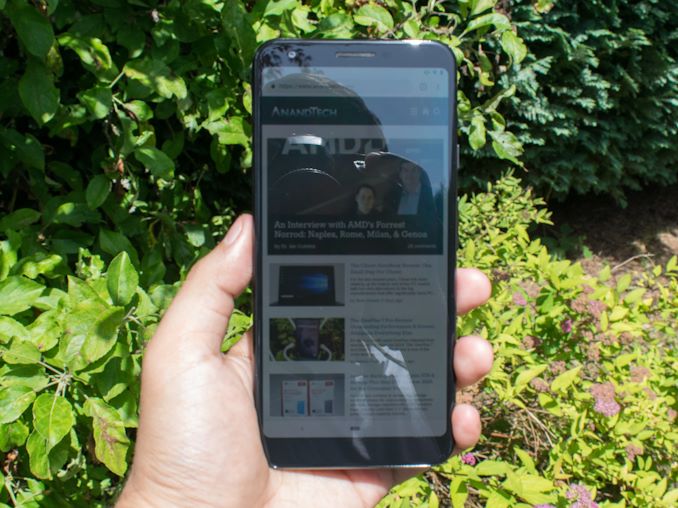
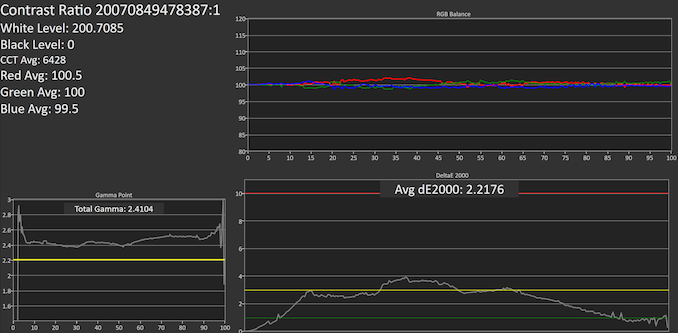


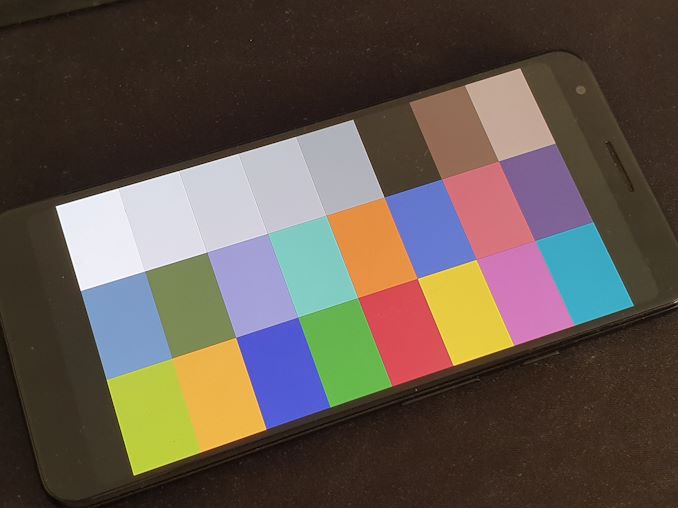









94 Comments
View All Comments
Threska - Sunday, June 30, 2019 - link
"Besides, it wears off on devices that are constantly being fondled by their owners."Alright everybody, stop "fondling" your phones. People are starting to talk. :-D
PeachNCream - Thursday, June 27, 2019 - link
The lack of microSD is a huge pain in the arse for people that use their phones as primary compute devices. That's been a brain dead move on Google's part for a long time now so it isn't a surprise. Also, mid-range and $400-500? Someone is on some good drugs if they're positioning a device with that kind of price in the middle as it falls in on the lower end of insanity, a fair bit above high priced.UtilityMax - Thursday, August 1, 2019 - link
So your phone is the primary storage for all your data, documents, music, tax returns, games, etc? Interesting choice..sing_electric - Thursday, June 27, 2019 - link
Even in North America, the value proposition of the Pixels kind of falls apart when you look at actual "street" pricing - Samsung's and LG phones often go on sale for significantly less than their MSRP (even at or near launch), and carriers (and the OEM) tend to fofer more generous trade-ins than Google seems to be willing to do.I've seen the S10e - S855, more RAM and more (and faster) storage, wireless charging, multiple cameras - go on sale for $500, just $20 more than the 3a XL, and its screen size slots it directly between the smaller and larger Pixels.
Not that any of it matters, though, because Google's done such a terrible job marketing the Pixel line that I don't think they'd be a sales hit no matter what...
melgross - Thursday, June 27, 2019 - link
Almost nobody buys Pixel labeled products, just as they didn’t buy Nexus labeled products before them,I understand that Google is trying to, at least partly, move away from being an advertising company, needing more user data in order to survive. But their hardware is a waste of time. It’s never going anywhere, just like Microsoft’s hardware, other than the XBox, which they’re still losing money on.
Speedfriend - Friday, June 28, 2019 - link
"Almost nobody buys Pixel labeled products" that is why they were the third best selling phone type in the US and 5th best in western Europe in Q4 2018MadManMark - Monday, July 1, 2019 - link
All you just did here was demonstrate to knoweldgable readers that we should ignore all the other posts you made to this thread because you simply don't know what you are talking about.darkswordsman17 - Thursday, June 27, 2019 - link
Er, that's a weird argument considering the sales that happened immediately on the Pixel3A. Especially for older Pixel owners (1 or 2) where they were effectively getting it for free after trading in their older Pixel. There's sales on all sorts of phones, so unless its an official MSRP change, then reviewers need to based their value propositions on that. Many people do not quality for some of those sales as it requires new activation or adding a line and good enough credit (or the ability to pay MSRP+tax and then get it back via bill credits). Or various other loops you have to jump through.What other marketing do you want them to do? I watch as little content that includes commercials as possible but I saw as many Pixel ads as I saw iPhone ads when I did. Not only that, but its not like they need the marketing, anytime they bring out a new phone the entire tech media discusses it just like they do iPhones and Samsung's phones. They don't sell like either of those, but I don't think that was ever Google's actual intent with the Pixel stuff.
UtilityMax - Thursday, August 1, 2019 - link
All the "cheap" new phones require activation of new line, or contract, or some kind of monthly payment plan. Moreover, the carrier branded LG phones are probably the worst garbage I have seen among android phones.3DoubleD - Thursday, June 27, 2019 - link
The article says the Pixel 3a XL compares well to the S835, but the charts show it comparing well to the S845, which is found in the Samsung Galaxy S9+. In fact, the S8/S8+ that would have the S835 SoC isn't even in the chart.